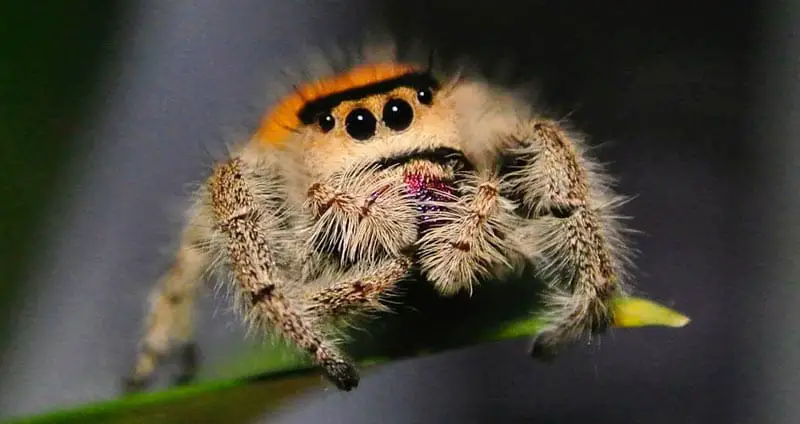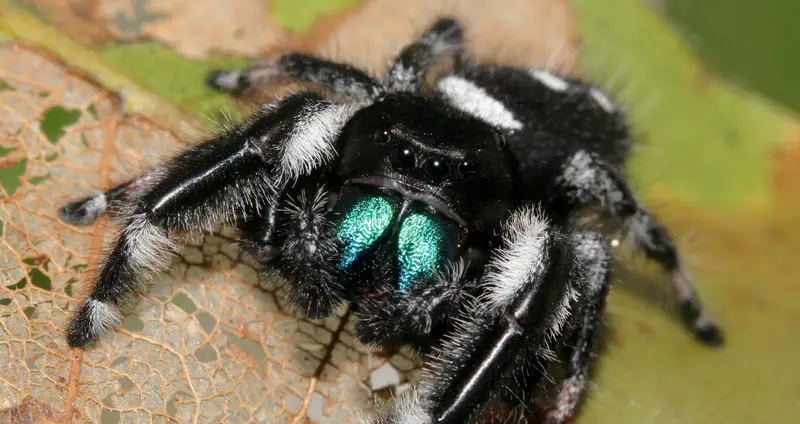Phidippus regius, also known as the Regal Jumping Spider, is a very popular and well-received type of spider. In fact, it’s the most commonly-kept species of jumping spider!
The popularity of this spider isn’t surprising in the least. Its adorable appearance combined with its easy care requirements and great temperament make it suitable for beginners and experts alike.
This post will tell you everything that you need to know about the Regal Jumping Spider. This includes what it looks like, how to feed it, and how to house it perfectly.
Table of Contents
Phidippus regius Care Sheet
| Common Name |
Regal Jumping Spider |
| Habitat | Southeastern United States (Florida), Greater Antilles, and Bahamas |
| Growth Rate | Fast growth rate, reaching maturity in several months. |
| Adult Size | Females typically grow to about 3/5″, while males reach around 1/2″. |
| Lifespan | Short-lived spiders that only live for about a year. |
| Enclosure | A small enclosure with an even amount of horizontal and vertical space is optimal. Two inches of substrate should be present, in addition to different materials to climb/web on. A water dish should also be present. |
| Temp/Humidity | Around 75°F with no specific humidity requirements, just consistent misting. |
| Diet | Good eaters that start off by eating fruit flies but transition into larger feeder insects. Food must be smaller than their abdomen. |
| Temperament | Very smart, curious, and fun spiders. They tend to take an interest in their owners and can even be trained to some degree. |
| Experience Level | Beginner – These spiders are easy to care for with basic requirements and a friendly temperament. |
| Average Cost | Slings ~ $10, Males ~ $20, Females ~ $30 |
Phidippus regius Appearance
It’s no surprise that the physical appearance of these spiders is one of the driving forces behind their popularity. This spider is remarkably small with huge eyes and an almost socially-awkward stance.
These spiders are very small in size. Females mature to be about 3/5″, while males tend to be smaller at around 1/2″. They also weigh just a few milligrams.
Males and females of this species are very easy to tell apart — no subtle differences here. Males are always black with white spots on their abdomen below a white band. Females have the same patterns, but they can range in color from gray to orange.
Phidippus regius‘ genus is well-known for its large size (comparative to other jumping spiders) and iridescent chelicerae, or “jaws”. The Regal Jumping Spider typically has blue-violet chelicerae.
These chelicerae are often blocked by the papli, though, which are oversized and covered with white hair.
Then, of course, their eyes! These jumping spiders have three rows of eyes, with the first row being quite large and visible from head-on.

Phidippus regius Temperament
Another prominent reason why these spiders are so popular is because of their friendly personalities. Much like the famous Lucas the Spider, Regal Jumping Spiders are curious, gentle, and love to jump.
As opposed to most tarantulas, this spider seems to form a bond with their owner. At least, that’s how they act.
Phidippus regius is known to recognize people, take interest in things that are going on in the world around them, and explore. Owners frequently handle their spiders for extended periods of time without then become flighty.
In their enclosures, Regal Jumping Spiders spend their time either sleeping in their web sack or simply jumping around.
These spiders are small, so it can be risky to take them out of their enclosure. Handle yours with caution first, then get more relaxed as time goes on.
Housing Phidippus regius
Keeping a Phidippus regius is easy not only because of their small size, but also because of their very basic care requirements! Some spiders are easy to care for, while others require excessive attention. This is one of the easy spiders.
All that this jumping spider requires is a small enclosure with good airflow and just a few accessories — that’s it! They don’t even require special temperatures and humidities.
Optimal Enclosure
There isn’t one set “best enclosure” for Phidippus regius. As these spiders are so small and adaptable, owners keep then in a variety of different enclosures to nearly all high levels of success.
This enclosure is essentially all that P. regius needs. It has several inches of length, width, and depth, and it’s also quite secure and breathable. This gives plenty of space for exploration while still being easy to build and maintain.
It’s very important that the enclosure, no matter which one you go with, has great cross-ventilation. It’s easy to find a small enclosure for this spider and place them in it without thinking about this aspect.
Enclosure Decorations
Decorating the enclosure is not a difficult task — especially with how small it is! There are just a few supplies that every jumping spider enclosure requires in order to make it very safe and comfortable.
First and foremost, the ground of the enclosure should be lined with about 2″ of moisture-retaining substrate like coconut fiber. This provides a soft flooring, keeps the enclosure clean, and maintains a healthy humidity level.
On top of that substrate, you should place some small branches/twigs and a fake plant or two. This provides the spider with plenty of area to climb and build webs.
Personally, I also like to provide a small water dish. This works to prevent dehydration and also contributes to consistent humidity.

Enclosure Temperature/Humidity
While it may be easy to think that these spiders require specific temperature and humidity levels, that’s not actually the case! These spiders are very neutral in their requirements, making it very easy to care for them.
A Phidippus regius‘s optimal temperature is right around room temperature for most people.
If your house gets extremely cold in the winter, some supplemental heating may need to be provided through a space heater. This often isn’t necessary, though.
Humidity levels don’t need to be around anything specific, either. To maintain humidity levels, simply mist one side of the enclosure with water once every 2-3 days. Don’t spray the spider!
Light levels do need to be considered, though. These spiders absolutely love light, so they should get quite a bit of light during the daytime.
Placing them near a window is good, but make sure that their enclosure isn’t heating up as a result. If they’re not getting enough light still, an LED lamp works great.
Diet
Feeding these tiny spiders does require a bit of consideration. As they’re so small, they can’t be fed standard insects — at least not for a while.
As young spiderlings, you should feed your Phidippus regius flightless fruit flies or tiny pinhead crickets as frequently as they’re willing to eat. At least 1-3 times per week.
Eventually, as the spider grows, it will stop seeing these small insects as food and will simply refuse to eat them. Before they hit this point, you should transition them to larger food.
This larger food can be small mealworms or crickets — as long as they’re shorter than your jumping spider’s body.
Always be sure to clean out any uneaten food from the enclosure, as it may pose a health risk and just isn’t sanitary.
Health Concerns
There are very few health concerns when it comes to Phidippus regius. As long as its enclosure is well-built and secure and its diet is complete, there are very few things that can go wrong.
Perhaps the most common problem that owners run into with their jumping spider is dehydration. This is a result of inadequate enclosure spraying and lack of a water dish.
To avoid this, be sure to spray the enclosure with water at least twice a week. You can use a digital thermometer/hygrometer to measure conditions and see if they’re getting too dry.
Additionally, damage can occur if this spider jumps or just falls a long distance. Therefore, whenever you handle your Regal Jumping Spider, do it above a soft surface.
Phidippus regius For Sale & Price
If you want to acquire one of these creatures, it’s very easy for you to do so. There are many sellers that are willing to sell this species of spider for an extremely low cost.
This low cost comes from its small size, the fact that it’s quite common, and its short lifespan.
You can purchase a tiny spiderling for under $10 in some cases, while males and females sell for between $20 and $30. This price often includes shipping and a safe arrival guarantee, so the value can’t be beat!
So, if you’re looking to bring home an adorable, energetic, curious spider, there’s almost nowhere better to look than Phidippus regius.


Hello i am very interested in starting a “colony” of phids here in South Africa and i have contacted a breeder in the UK who can import safely but i need some information about breeding. Please contact me ASAP